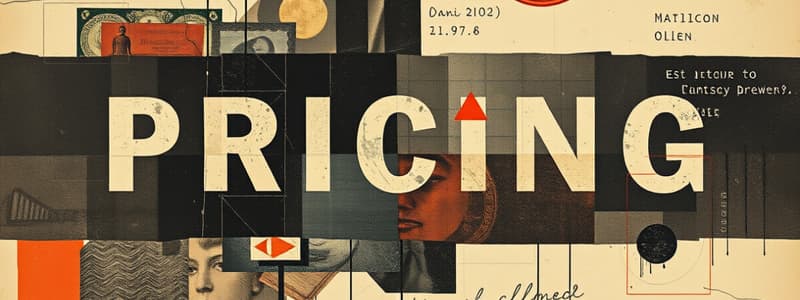Podcast
Questions and Answers
Which market structure consists of only one firm controlling the entire market?
Which market structure consists of only one firm controlling the entire market?
- Pure Competitive Market
- Monopolistic Market
- Oligopolistic Market
- Pure Monopoly Market (correct)
What is a primary characteristic of a pure monopoly regarding product differentiation?
What is a primary characteristic of a pure monopoly regarding product differentiation?
- Products are similar to competitors
- Products are highly differentiated
- Products are a combination of multiple categories
- Products are homogeneous (correct)
What does a high barrier to entry in a pure monopoly market imply?
What does a high barrier to entry in a pure monopoly market imply?
- Significant obstacles like patents and regulations (correct)
- High number of firms competing
- Minimal control over market share
- Easy entry and exit for new firms
In which market structure do firms have some level of control over their prices due to product differentiation?
In which market structure do firms have some level of control over their prices due to product differentiation?
In an oligopolistic market, what is a notable feature concerning the number of firms?
In an oligopolistic market, what is a notable feature concerning the number of firms?
What is the primary difference between value-based pricing and cost-based pricing?
What is the primary difference between value-based pricing and cost-based pricing?
Which pricing strategy involves adding a standard markup to the cost of a product?
Which pricing strategy involves adding a standard markup to the cost of a product?
What is a characteristic of good value pricing?
What is a characteristic of good value pricing?
Which of the following is not considered a type of cost in cost-based pricing?
Which of the following is not considered a type of cost in cost-based pricing?
In which type of pricing are competitors' prices and strategies primarily considered?
In which type of pricing are competitors' prices and strategies primarily considered?
What defines break-even pricing?
What defines break-even pricing?
What is an example of value-added pricing?
What is an example of value-added pricing?
Which factor is primarily considered in determining fixed costs?
Which factor is primarily considered in determining fixed costs?
Flashcards are hidden until you start studying
Study Notes
Price: Meaning & Importance
- Price is defined as the amount of money charged for a product or service, reflecting the values exchanged for benefits received.
- Importance of price includes profitability, market positioning, and influencing customer perceptions.
Objectives of Pricing
- Establishing a competitive edge in the market.
- Achieving financial goals and profitability.
- Influencing customer behavior and demand.
Price Determination
- Price determination involves analyzing costs, customer value, and competitive landscape.
- Different pricing objectives include maximizing profits, increasing market share, and maintaining stability.
Factors Influencing Price Determination
- Cost structures: fixed and variable costs play crucial roles.
- Customer perception of value and willingness to pay.
- Competitive pricing strategies and market conditions.
Pricing Strategies
-
Cost-Based Pricing: Prices set based on costs of production, distribution, and selling.
- Fixed costs are constant regardless of output.
- Variable costs fluctuate with production levels.
- Total costs comprise both fixed and variable costs.
-
Types of Cost-Based Pricing:
- Cost-Plus Pricing: Standard markup added to the cost of products.
- Break-Even Pricing: Targets to cover costs and achieve a specific return on investment.
- Competition-Based Pricing: Setting prices according to competitors’ strategies.
- Target Costing Pricing: Begins with a desired selling price and works backward to ensure target costs.
-
Value-Based Pricing: Prices grounded in customers' perceptions of value rather than seller costs.
- Good Value Pricing: Offers quality and service at a fair price.
- Value Added Pricing: Includes additional features or services to justify higher prices, exemplified by products like Philips LED lights.
Pricing in Different Types of Markets
- Pure Competition: Many firms offer similar products; prices are determined by market demand.
- Monopolistic Competition: Many firms with differentiated products; some control over prices.
- Oligopolistic Market: Few large firms dominate; interdependent pricing strategies due to limited competition.
- Pure Monopoly Market: Single firm controls the market; significant price-setting power.
Market Aspects Summary
- Number of Firms: Ranges from many in pure competition to one in a pure monopoly.
- Product Differentiation: Varies from homogeneous in pure competition to unique in a monopoly.
- Control Over Price: Present in monopolistic and oligopolistic markets; absent in pure competition.
- Entry Barriers: High in oligopolies and monopolies; low in competitive markets.
Studying That Suits You
Use AI to generate personalized quizzes and flashcards to suit your learning preferences.




